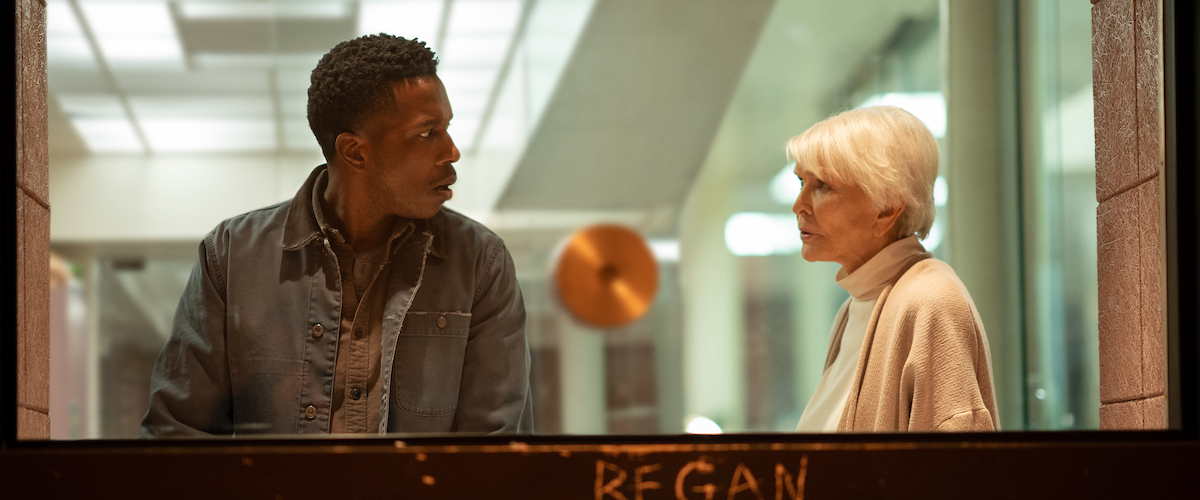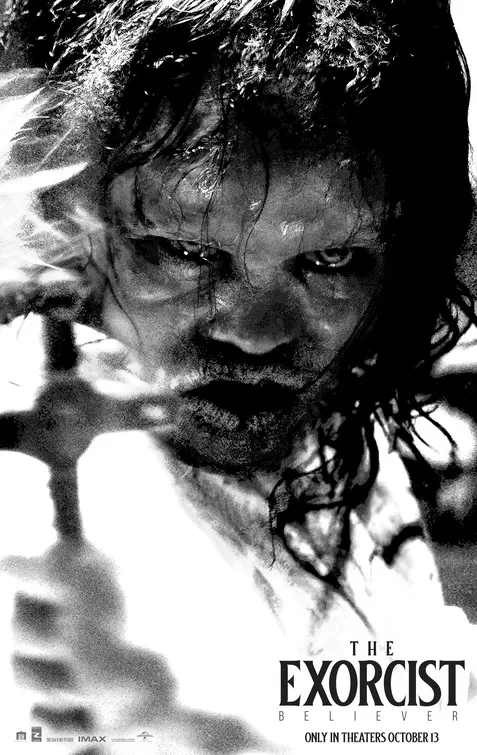“The Exorcist: Believer” is a pretty good movie that’s so stuffed with characters and not-quite-developed ideas that you may come away from it thinking about what it could have been instead.
Directed and co-written by David Gordon Green, who recently oversaw a trilogy of “Halloween” sequels, it focuses on the simultaneous possession of two young girls (apparently by the same demon that haunted the first movie) and the harmonic convergence of parents and clerics trying to liberate them from evil. It’s probably the first “Exorcist” sequel since 1977’s fitfully brilliant “Exorcist II: The Heretic” to capture the persistent sense of the uncanny that made William Friedkin’s first entry in the series a smash hit.
The opening third, which sets all of the narrative pieces in place, is the slowest and subtlest part of the movie. But it’s also the most satisfying because of the confident way it uses silence, misdirection, and negative space to make the audience wonder if evil is already present in the story or if we’re just being paranoid. Green has clearly studied William Friedkin’s original as if it were a holy (or unholy?) text and reproduces some of the master’s techniques for setting viewers on edge: for instance, adding a disruptive sound (such as a car horn) when the movie cuts from one scene to another, or cutting away to unnerving, oddly framed closeups (flashes of demonic faces and bloody wounds, shots of jackhammers, and so on) when characters are having important conversations. The film becomes less compelling as it goes along, however, ultimately succumbing to the horror movie equivalent of the problem that often afflicts superhero movies packed with lots of heroes and villains. The story’s energy gets dispersed, and the movie gradually loses touch with the source of its initial power, the privilege of focusing on the main characters: a widowed father named Victor Fielding (Leslie Odom Jr.) and his daughter Angela (Lidya Jewett).
We meet Victor in the film’s prologue, set in Haiti, where Victor and his very pregnant wife, both photographers, are vacationing. An earthquake collapses the building they’re staying in and crushes her, though not before she accepts the locals’ blessing to protect the baby. Doctors tell Victor they can save his wife or unborn daughter, but not both. We know how that turned out. The script elides exactly how the decision came about and how it affected Victor, saving it all for future revelations and gradually expanding flashbacks.
Thirteen years later, father and daughter live in Atlanta, Georgia, where Victor has a thriving photographic portrait studio. The now-13-year-old Angela asks permission from her understandably super-protective father to have her first-ever after-school studying visit with a classmate: her best friend Katherine (Olivia O’Neill), whose parents (Jennifer Nettles and Norbert Leo Butz) are Catholic. Unfortunately, this is no ordinary study break: the girls spent a couple of furtive hours in the woods near the school, communicating with a spirit at the bottom of some kind of abandoned shaft, and emerged, um, different.
The movie initially seems as if it’s going to be another Catholicism-centered exorcism flick, but this is a misdirection that sets up some good jokes (not on Catholicism itself, but the way so many exorcism movies treat the Vatican as the spiritual equivalent of The Avengers). The film ultimately opts for more of a United Nations-of-spirituality approach, noting that most cultures throughout history have had equivalents for possession and exorcism, then assembling experts to attack the demon from multiple theological angles.
Raphael Sbarge plays the priest at Katherine’s family’s church who bears witness to a disturbing outburst by the demon-possessed girl, who grows increasingly impatient and irritable as a Sunday service unfolds. Ann Dowd has a supporting role as Paula, a next-door neighbor who realizes while caring for Angela at the hospital that the kid isn’t acting that way because she’s got the flu. Though not an ordained holy person, Paula has connections to the Catholic faith and rallies to the cause. She’s joined by Father Maddox (E.J. Bonilla), a goodhearted but fainthearted young padre who goes to the Church seeking permission for an official, sanctioned exorcism and ends up becoming a bit like the skittish young priest that Richard Pryor played in the old “Saturday Night Live” parody of “The Exorcist” (“Father, where is your faith?” “It’s in the car … I’ll go get it!”) There’s even a demon-battler imported from Haiti (Okwui Okpokwasili) who pushes Victor to reconnect with beliefs he rejected after his wife’s death.
Then, of course, there’s Chris McNeil (Ellen Burstyn), the mother from the original “The Exorcist,” making a “legacy sequel” appearance that connects this entry to the series’ origin point. The handling of Burstyn’s character is, unfortunately, the weakest part of the film’s midsection—a study in misdirection that disappoints rather than surprises or delights. The movie sets up conditions wherein Chris seems poised to become this sequel’s version of Max von Sydow’s battle-hardened old priest in the first movie, and channels Burstyn’s offscreen involvement with spiritually-oriented subjects and causes, then builds and builds and builds to the sequence where Paula gives Victor the memoir Chris wrote about her daughter’s possession and recovery and then … pffft. Nothing. After one big scene, “The Exorcist: Believer” seems to have to remind itself that she’s part of the story and find ways to connect her to the other characters through editing.
Green keeps all the different elements in play and tries not to short-shrift any particular character. It’s not easy, apparently. But the movie has personality, at least. Green has had one of the oddest careers in Hollywood, starting out with achingly sincere independent dramas (“George Washington,” “All the Real Girls“), pivoting to stoner comedies (“Pineapple Express,” “Your Highness“), and somehow ending up in major-label franchise horror. He knows his way around this genre, and he doesn’t just apply the “Halloween” template again; he knows it’s a different kind of story that requires a more patient and earthy approach. The movie’s quasi-documentary impulse (complete with handheld camerawork and French New Wave-style editing in montage scenes) goes a long way toward making you believe that you’re seeing plausible individuals confronting the unspeakable and unmeasurable.
But in the end, the movie still becomes more of an exercise in logistics than the kind of work that’ll keep you up till dawn wondering if you made sure to close every window to prevent the dreaded demon Pazuzu from sneaking in and possessing you (which is how the writer of this piece spent several insomniac months after seeing the original “Exorcist” on TV as a child). The performances are all beyond reproach, even in relatively small roles like that of Sbarge’s priest, a showboater shocked and humbled by what he’s gotten himself into. Odom is especially impressive because his character is so internalized and uncommunicative, but he still manages to get across the father’s distress and complex and often contradictory emotions. The child leads are superb and seem to be having fun saying horrible things to adults.
If only the exorcism itself had any novelty, much less real dramatic power: between the fact that nearly ever exorcism sequence is basically the same and the glut of “Exorcist”-type projects in recent years (including the original, excellent “The Conjuring” and the “Exorcist” TV series), there’s nothing in the final sequence that will shock or even surprise viewers, except for a few character moments that would have landed harder if the large cast of characters were more finely etched. The climax of this one doesn’t hit as hard as it should because we haven’t gotten to know all the people in that evil-infused room (not to mention the details of their faith). The spectacular movie moments that screenwriter William Goldman called “The Whammies” can’t knock the viewer over unless the characters have weight.
Friedkin excelled on both fronts: the drama and the whammies. The original is still effective because it takes its sweet time establishing characters who seem like real people, then puts them and the audience through a prolonged, brutal ordeal together—one that, at the time, no one had ever seen on a screen before. Clocking in at a relatively breezy 121 minutes in length, “The Exorcist: Believer” is a rare case where a long cut would play better than a short one. Given that the hero and his late wife were photographers, you’d expect photography to play into this film the way sound recording did in the first one, but either the script isn’t interested or just part of the movie got cut down to almost nothing. And there are a lot of underdeveloped themes and elements, including the notion that a culturally divided America needs to come together for the sake of the children, as well as oddly off-brand positive exhortations that everything happens as it should, even trauma, and there would be less evil in the world if we were more emotionally connected to one another. The message at the end isn’t, “The real exorcist is love,” but it almost seems that way.
In theaters October 6th.




















